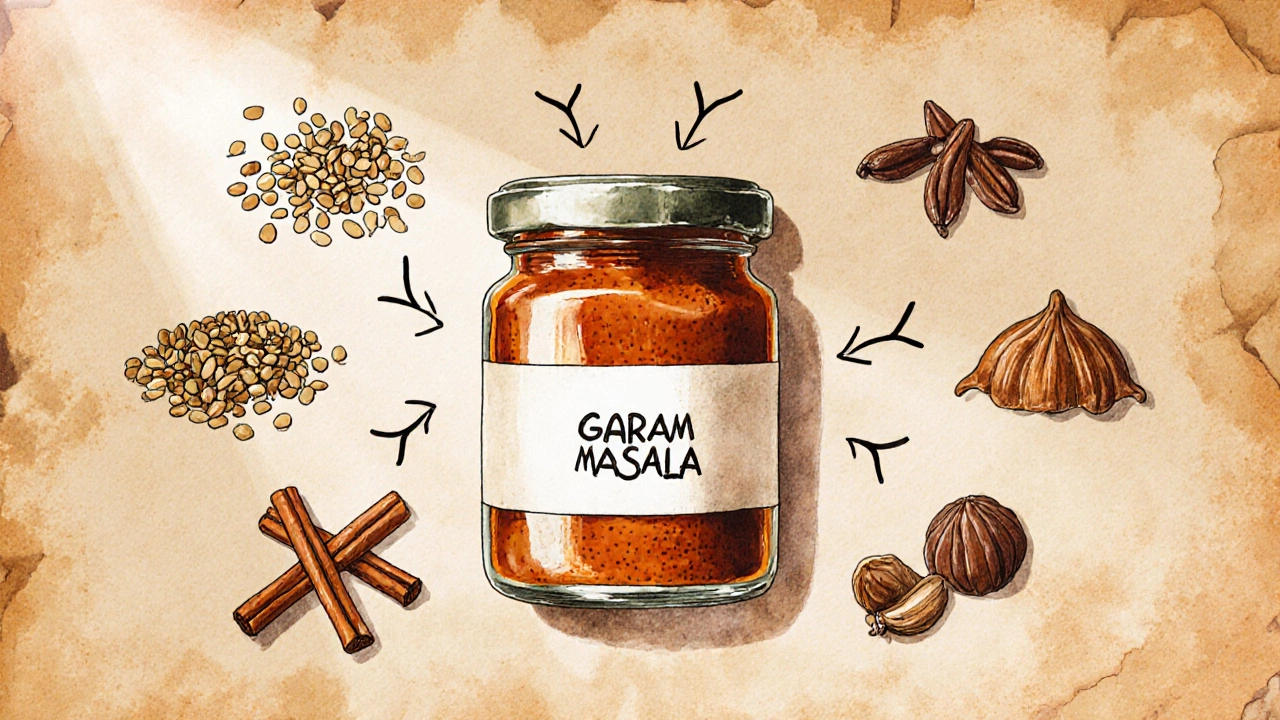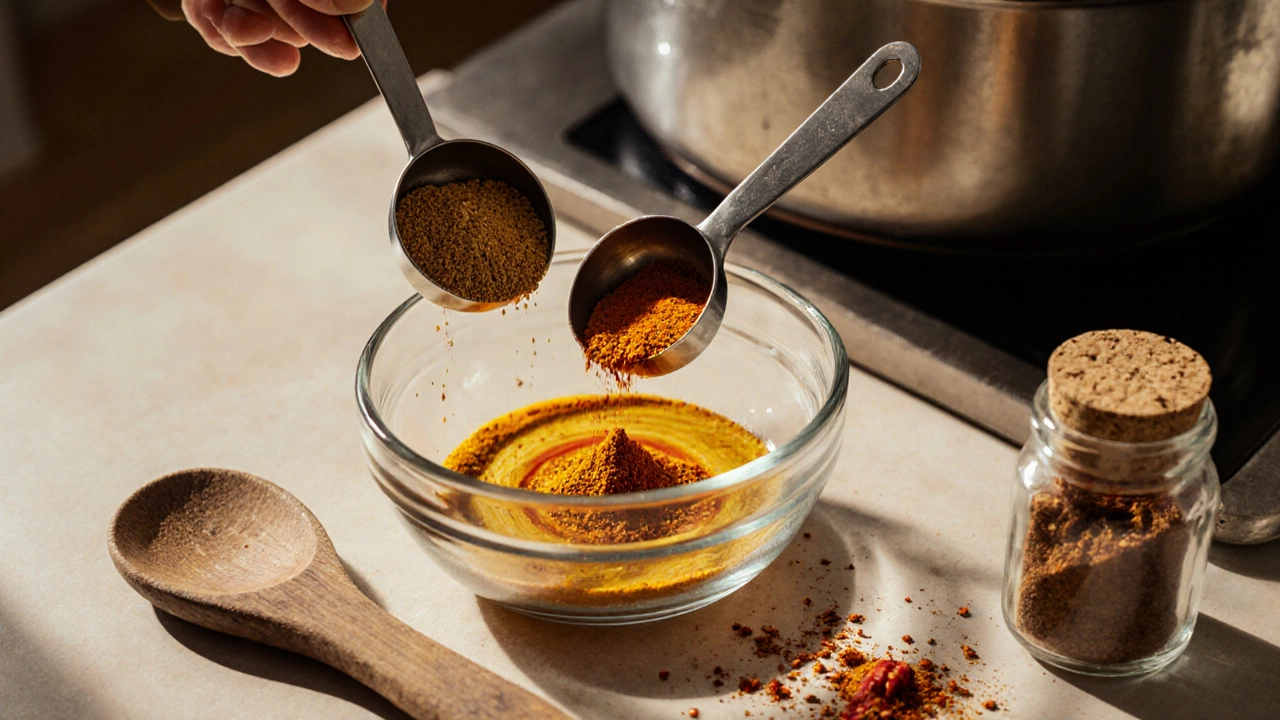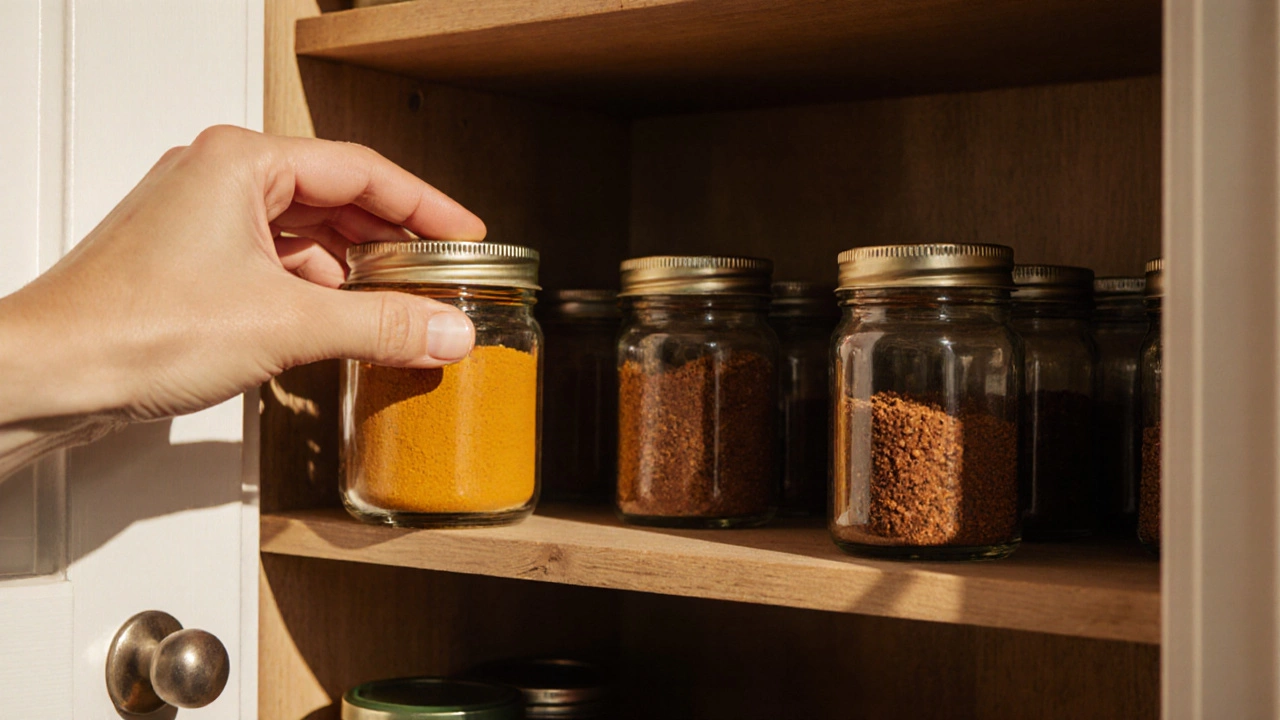Curry Powder Substitute Calculator
Select the spices you have on hand, choose your preferred heat level, and click "Calculate" to get a custom curry powder substitute recipe.
Your Custom Curry Powder Substitute
Ever opened a pantry and wondered which single spice can give you that familiar curry powder substitute feeling without rummaging through a whole blend? You’re not alone. Many home cooks face the same dilemma when a recipe calls for curry powder but they only have a handful of other spices on hand. The good news? A few stand‑alone spices share enough of the same flavor building blocks to act as a close match, and knowing which one to reach for can save a meal and a trip to the store.
Key Takeaways
- Curry powder’s core flavors come from turmeric, cumin, coriander, and a hint of heat.
- Garam masala is the single spice that most closely mirrors curry powder’s complexity.
- Turmeric alone can deliver the signature golden colour and earthy note, but needs extra aromatics.
- For a quick swap, mix equal parts cumin and coriander, then add a pinch of chili powder and a dash of turmeric.
- When buying, choose fresh, aromatic spices and store them in airtight containers away from light.
What Makes Curry Powder Unique?
Curry powder is a blend of ground spices traditionally used in Indian and South‑Asian cooking. Its classic profile includes turmeric for colour, cumin for earthiness, coriander for citrusy brightness, and a modest heat from chili powder or fenugreek. Some regional versions add mustard seed, ginger, or cloves, but the four‑spice core remains consistent across most commercial mixes.
Spice That Comes Closest to Curry Powder
When you need a single spice that mimics the overall vibe of curry powder, consider these options. Each entry is introduced with microdata so search engines can clearly identify the entity.
Garam masala is a warm, aromatic blend usually featuring cumin, coriander, cardamom, cloves, cinnamon, and nutmeg. Unlike curry powder, it’s often added at the end of cooking, which preserves its fragrant oils. Because it shares many of the same base spices, it delivers a flavor profile that feels very close to curry powder, especially when paired with a splash of turmeric for colour.
Turmeric provides the bright yellow hue and an earthy, slightly bitter note. On its own it lacks the depth of cumin and coriander, but when combined with a pinch of chili powder it can act as a minimalist curry stand‑in.
Cumin offers a warm, nutty flavor that forms the backbone of many curry powders. Use it alone for a milder profile, or pair it with coriander to get closer to the full blend.
Coriander contributes a citrus‑like brightness that balances cumin’s earthiness. It’s a key player in curry powders and can be mixed with cumin and a hint of heat for a quick fix.
Mustard seed adds a subtle pungency that some curry powders include. Ground mustard can be whisked in with other spices for an extra kick.
Chili powder delivers the heat component. Choose a mild variety if you only want a whisper of spice, or go hotter for a bolder profile.
Fenugreek gives a slightly sweet, maple‑like undertone that appears in many curry mixes. A pinch can lift the overall flavor without dominating.

Why Garam Masala Is the Top Pick
Garam masala hits the sweet spot because it already contains most of the same aromatics found in curry powder. The primary difference is the timing: curry powder is typically added early to let its flavours meld, while garam masala is finished at the end of cooking. To use garam masala as a direct substitute, simply add a ½‑teaspoon of garam masala plus ¼‑teaspoon of turmeric at the start of the recipe. This trick keeps the colour, the warmth, and the aromatic depth.
DIY Quick Curry Powder Alternative
If you have a modest spice cabinet, you can whip up a decent stand‑in in seconds. Here’s a three‑step blend that approximates the classic profile:
- Combine 2parts ground cumin with 2parts ground coriander.
- Add 1part turmeric for colour and earthy depth.
- Stir in a pinch of chili powder (or cayenne) and a pinch of fenugreek for heat and a hint of sweetness.
Mix the powders thoroughly, store the blend in an airtight jar, and use it exactly like you would regular curry powder. The ratio can be tweaked-more chili for heat, more turmeric for colour, or a dash of ground mustard for a sharper edge.
Where to Find These Spices
Most supermarkets in Sydney carry the essentials: cumin, coriander, turmeric, and chili powder. For garam masala and fenugreek, check the international aisle or your local Indian grocery. Freshness matters-spices lose potency after about 12‑18months. Smell the jar: a vibrant, fragrant scent signals maximum flavour.

Comparison Table: Curry Powder vs. Closest Single Spices
| Spice | Key Ingredients | Flavor Highlights | Typical Use | Similarity Score (0‑10) |
|---|---|---|---|---|
| Garam masala | Cumin, coriander, cardamom, cloves, cinnamon, nutmeg | Warm, sweet, aromatic | Added at end of cooking | 9 |
| Turmeric | Pure turmeric root powder | Earthy, slightly bitter, bright yellow | Colour and earthy base | 6 |
| Cumin | Ground cumin seed | Nutty, warm, earthy | Core spice in many blends | 5 |
| Coriander | Ground coriander seed | Citrusy, light, fresh | Balancing aromatic | 5 |
| Chili powder | Ground dried chilies | Heat, smoky depth | Heat component | 4 |
| Fenugreek | \nGround fenugreek seeds | Sweet, maple‑like | Enhances depth | 3 |
Frequently Asked Questions
Can I use garam masala instead of curry powder in a stew?
Yes. Add about half the amount of garam masala and a pinch of turmeric at the beginning of the stew. This replicates colour and warmth while preserving the aromatic finish that garam masala provides.
What if I’m allergic to mustard seed?
Skip the mustard and boost the other aromatics-extra cumin or a dash of smoked paprika works well to keep the flavor rounded without the pungency.
Is there a low‑heat version of a curry‑like spice?
Mix cumin, coriander, and turmeric, leaving out the chili powder. You’ll get the earthy‑citrus base without noticeable heat.
How long do homemade spice blends stay fresh?
Stored in a cool, dark place in an airtight jar, a blended mix retains its peak flavour for about 12 months. Smell it before use-if the scent has dulled, it’s time to refresh.
Where can I buy high‑quality garam masala in Sydney?
Head to the markets at Central Sydney, visit a dedicated Indian grocery like “Spice Bazaar” in Alexandria, or order from reputable online retailers that list harvest dates and packaging dates.
Next Steps & Troubleshooting
If your dish still feels flat after using a single‑spice substitute, try one of these fixes:
- Boost aromatics: Add a splash of fresh ginger or a minced garlic clove.
- Adjust salt: Sometimes a pinch more salt helps release the spice’s hidden flavors.
- Finish with a dash of garam masala: Even a ¼‑teaspoon at the end can lift a bland base.
With the right spice on hand and a few quick tweaks, you’ll never be stuck waiting for a curry powder refill again.
